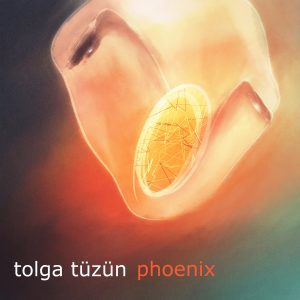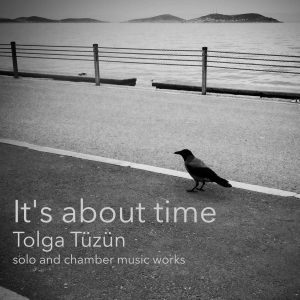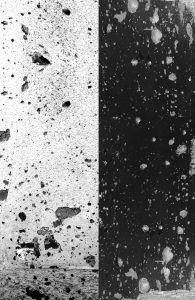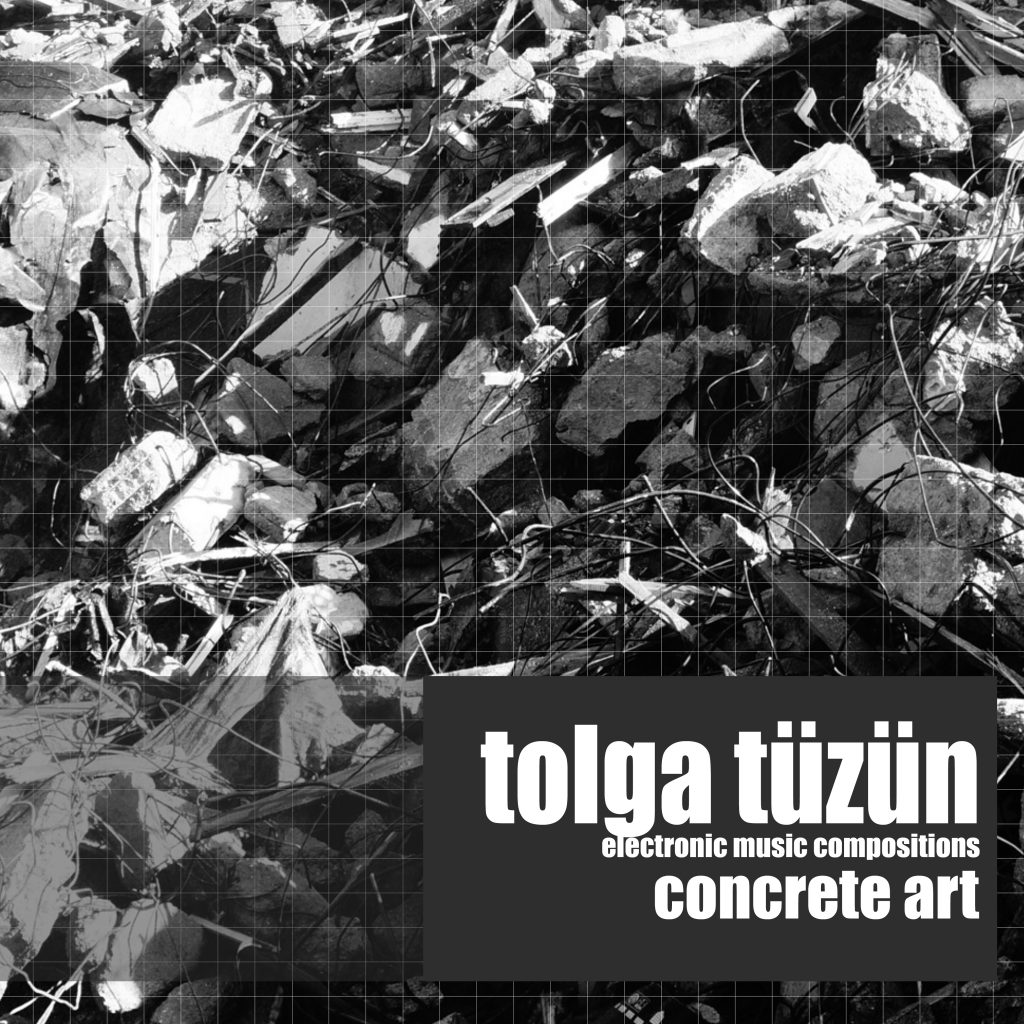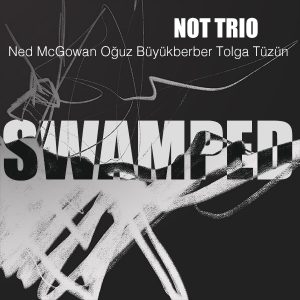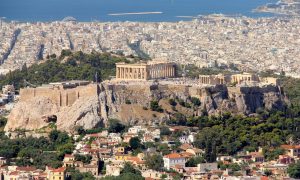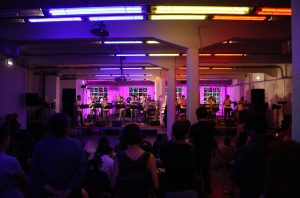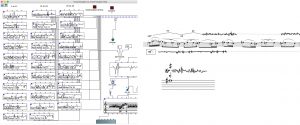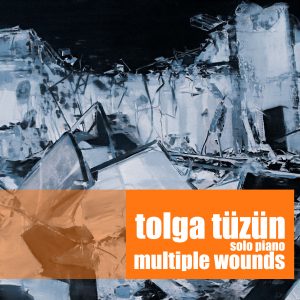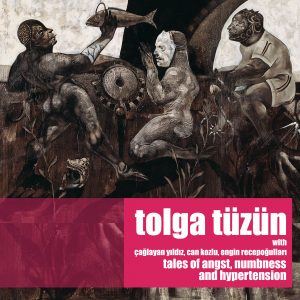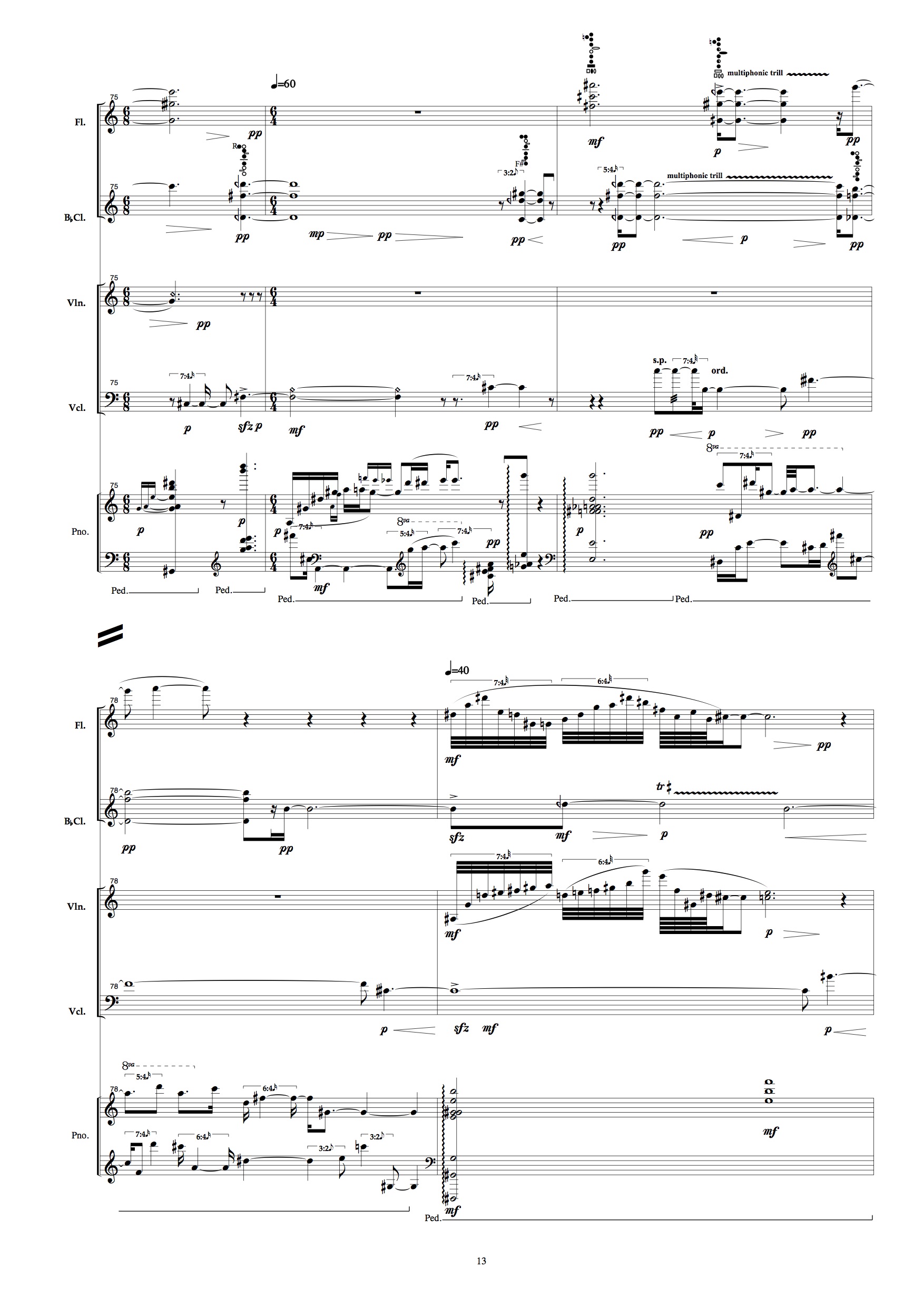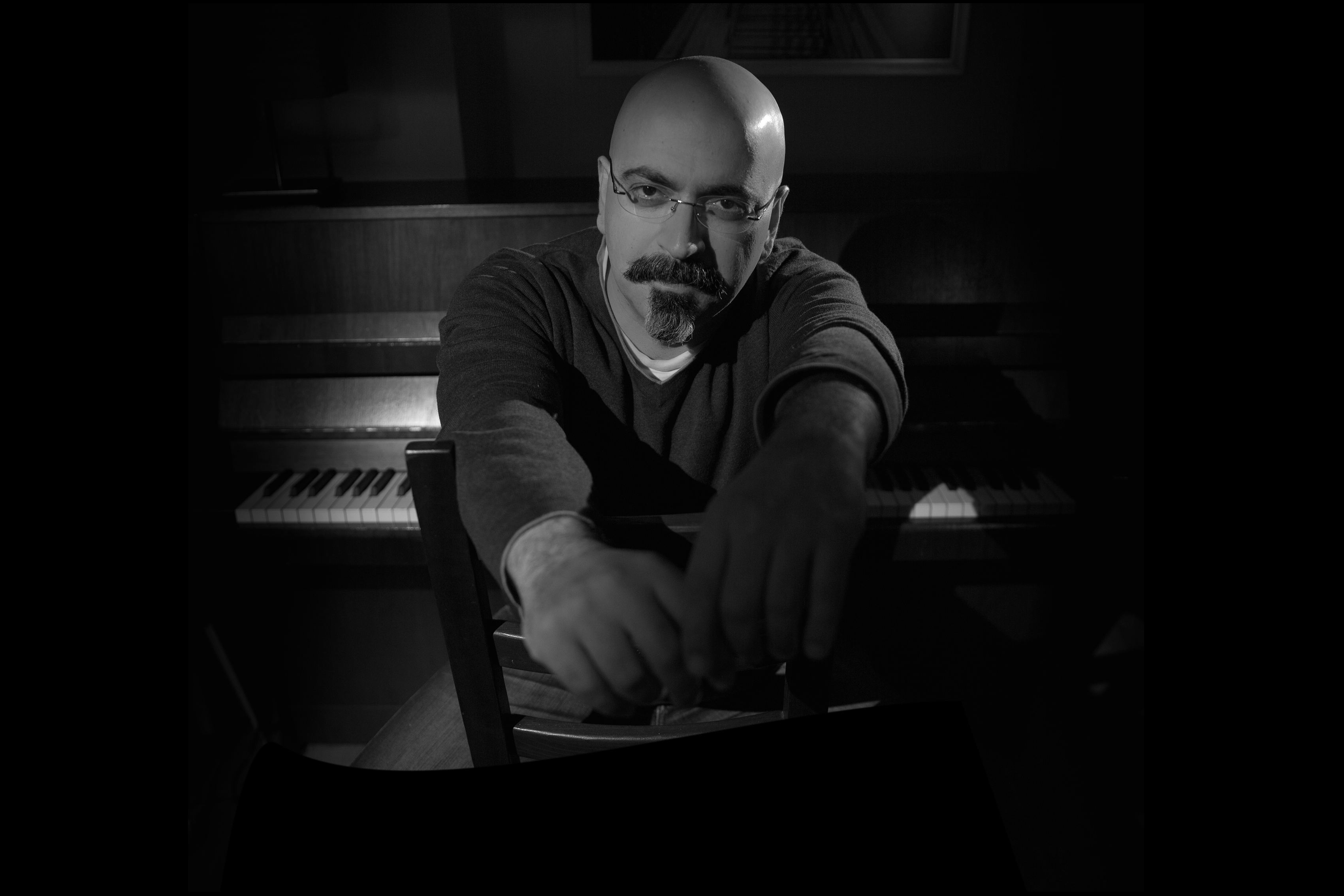Author Archives: tolgatuzun
It’s about time-Booklet
There are advantages and disadvantages of a digital release. Personally, the lack of a physical object—something that I can touch, smell, read—constitutes the most significant drawback. When digital platforms don’t supply any critical information about the album, it is up to the artists to fill the gap. Thus, I prepared a booklet for my latest album It’s about time wherein I put down information about the pieces, musician bios, some photography and my thoughts about the pieces. You can look at it on my website [here]. Hopefully very soon, I will have a printed version so that when I see people—whenever that might be— I will hand them an object and say “Hey, here is my new album.”
Again, here is my album…
It’s about time
It’s about time
Yes, it is about time for me to release another album of my compositions in contemporary music. The last one Periphery appeared in 2009. The subtitle featured “compositions for solo instruments and electronics sounds.” Now 11 years later, with a new one subtitled “solo and chamber music works,” I wanted to show you that I kept working and creating in this neoliberal environment that sucks the depth and joy of most of things and substitute them with shallowness and frivolousness. Consequently, most of the art that is around are sketchy gestures with cosmetic facades. I work hard for mine to not become one of those.
The album is called It’s about time. The title refers to an ensemble piece that I wrote in 2015. When we recorded that piece with Oerknal Ensemble in 2019, due to a computer malfunction we lost some of the takes of one of the sections of the piece. While considering not to include the piece to this collection, I had the idea to rethink it with what we have recorded. The form has changed which in turn changed the harmonic and sonic framework of the piece. So the new piece It was about time now it is not anymore is the only electroacoustic piece of the album. The composition of 2015, the acoustic version, gave its name to the album.
Music is a temporal art, everything we do is a function of Time. The object of our compositional act—sound— is bound with time. It is born within time, it exists only in time and it dies out with time. This is also true for its reception; listening to music takes time. Despite all the technological advances, there is not a formula, an algorithm nor a process that will enable you to listen to music in less time than it actually takes. This is a fortunate situation for us composers: if our music keeps the listeners interested, involved and engaged, they will lend us an ear for the time the music takes. Knowing that burdens us with responsibility and achieving that requires courage, endurance and hope. I know my music is not listener-friendly, but that doesn’t mean we can’t be friends. After all, do you have to like everything your friends say?
Les Traces de Notre Futur Antérieur
for viola, violoncello, double bass, percussion and electronics
“Misshapen chaos of well-seeming forms” William Shakespeare
“Natura respuit ut contraria quaeque iungantur” (Nature refuses the joining of unlike things) Boethieus
“There is a strange power in the joining of unlike things.”Carnival Row season 1 Ep.4 15:04
The most successful dystopic fictions are written not by merely imagining a “utopia-gone-wrong” places but by exaggerating the features of the past and the present that contain potentials for them to become dystopic. These dystopic features are to be sought in the contemporary canvas of our societies: social memory loss, disre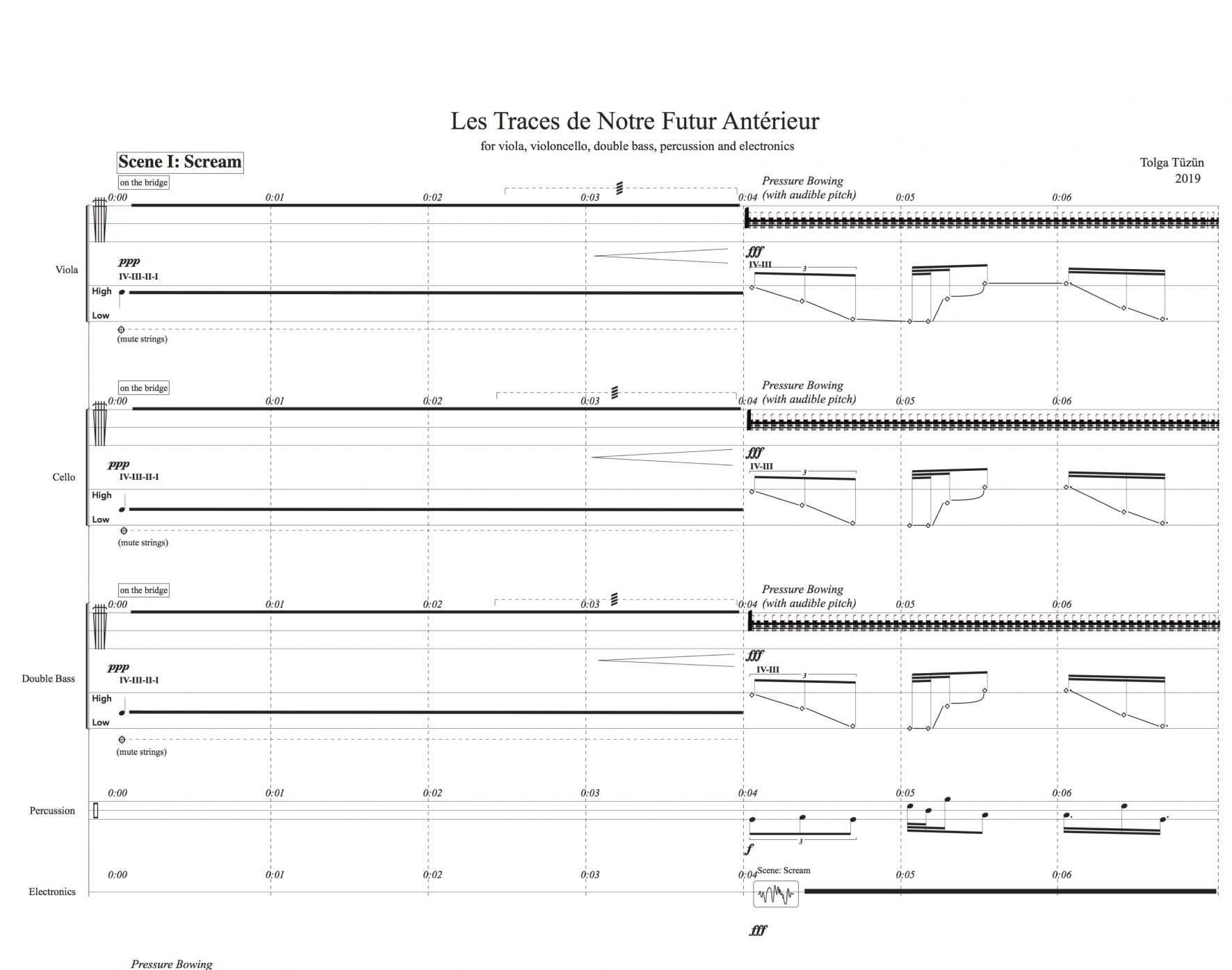 gard for differences, unfounded familiarities, traces of past mass violence. What we call “ourselves” in a modern society are interwoven acts of barbarisms and adequate forgetfulness/indifference that go along with them.
gard for differences, unfounded familiarities, traces of past mass violence. What we call “ourselves” in a modern society are interwoven acts of barbarisms and adequate forgetfulness/indifference that go along with them.
Les Traces de Notre Futur Antérieur for Hezarfen Ensemble takes this idea of “uncovering what is lost as a result of violence” and translates it into a musical circumstance that is inspired by the texts belonging to the people who once inhabited the Anatolian land for centuries.
Premiered by Hezarfen Ensemble on October 31st, 2019
Commissioned by Dystopia Festival
Concert recording: Gökhan Deneç
Tolga Tüzün’s sound design is at 58th Venice Art Biennale.
Tolga Tüzün composed and made the sound design for We, Elsewhere, a new work by İnci Eviner which will be presented in the Pavilion of Turkey at the 58th International Art Exhibition, La Biennale di Venezia, from 11 May through 24 November 2019.
The show is organised by the Istanbul Foundation for Culture and Arts (İKSV) and sponsored by Fiat. For more information : https://www.iksv.org/en/news/the-pavilion-of-turkey-hosts-inci-eviner-at-la-biennale-di-venezia-this-year
#tolgatuzun #incieviner #biennalearte2019#mayyouliveininterestingtimes #weelsewhere #bizbaşkayerde
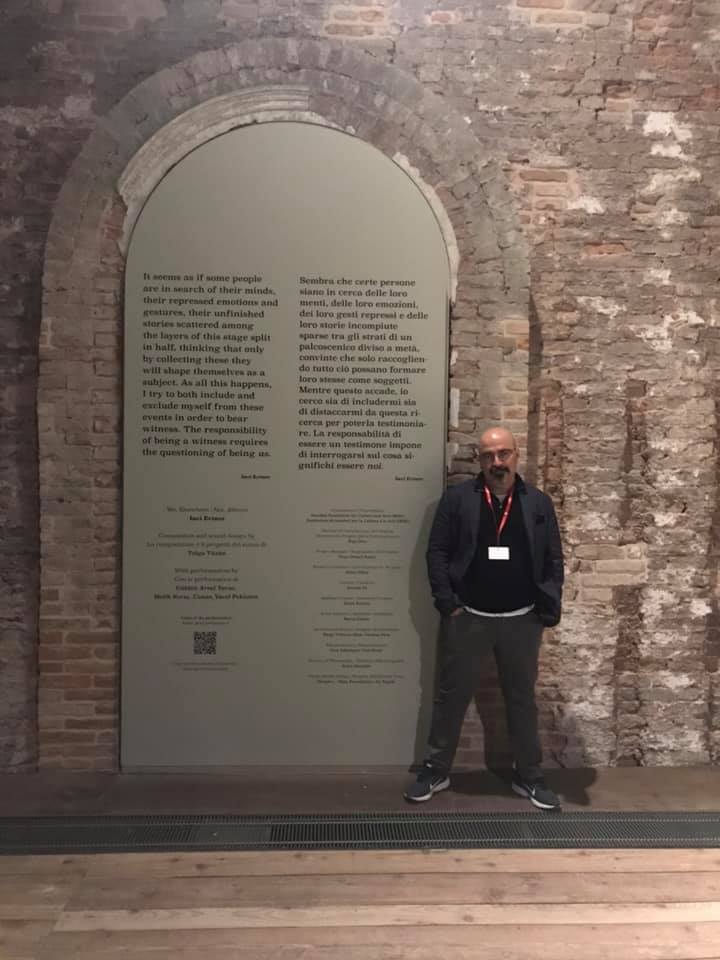
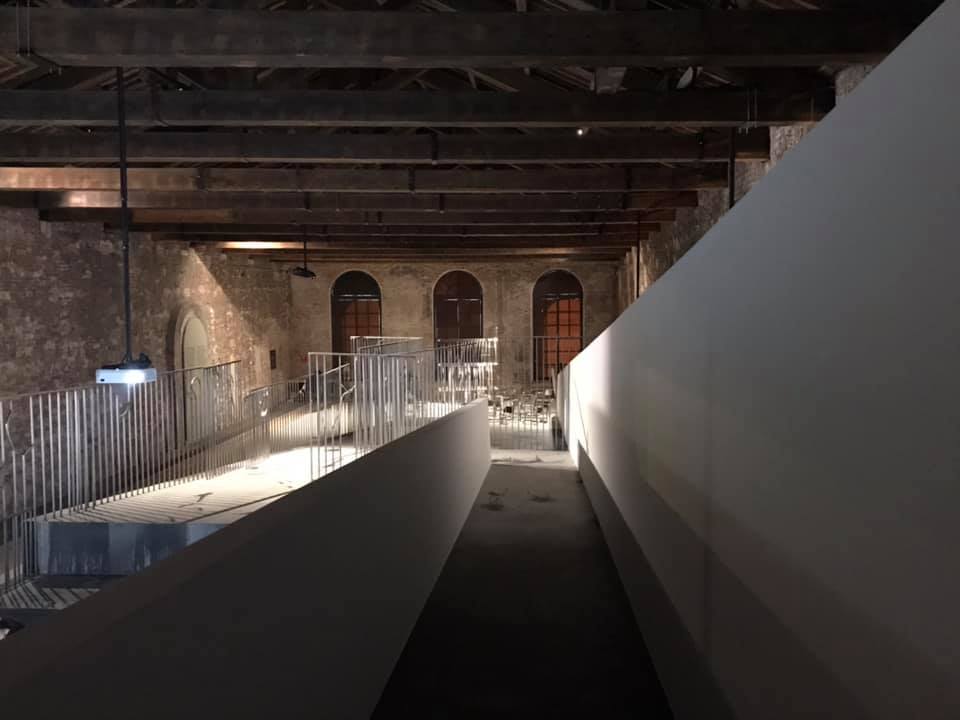
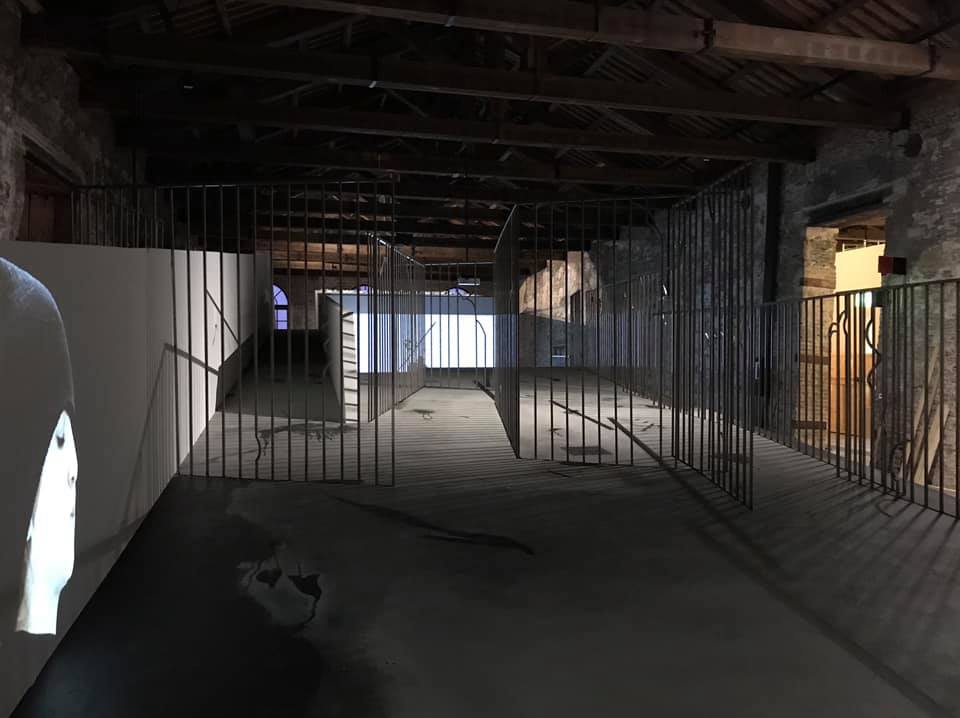
Concrete Art-Electronic Music Compositions
Estimate Map by Tolga Tüzün – Özgür Yılmaz
New Album by Tolga Tüzün (Piano) and Özgür Yılmaz (contrabass)
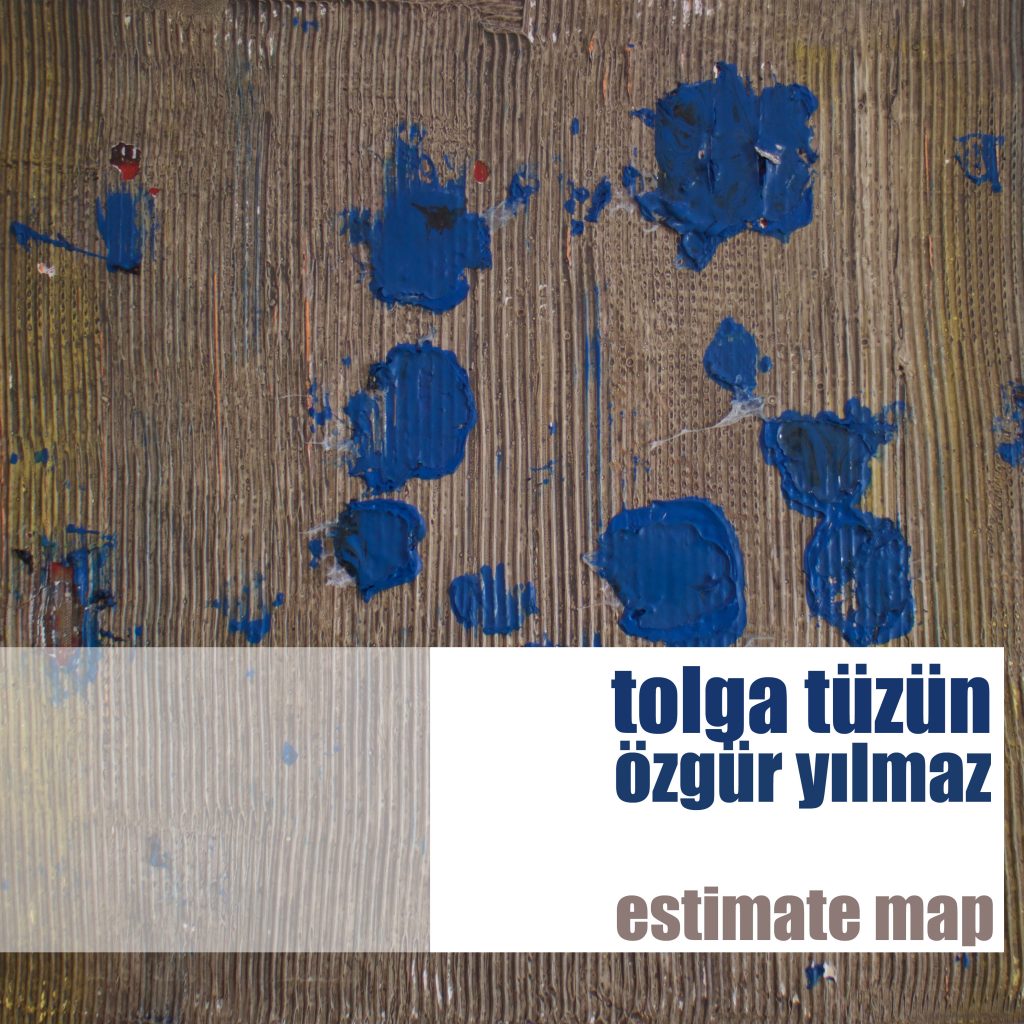
“Swamped” by NOT Trio
“Swamped”
by NOT Trio
Ned McGowan – Piccolo, Flute and Contrabass Flute
Oguz Buyukberber – Eb, Bb, Bass and Contrabass Clarinets
Tolga Tuzun– Piano
Oğuz Büyükberber, Ned McGowan and Tolga Tüzün come together once again as Not Trio, this time with a new program of experimental and eloquent works originating from the thought and expressive processes of these three accomplished performer/composers. Compositions with improvisations make up the bulk of the works here as their collaboration takes a big step to greater depths of listening, timing, communicating and carefully choosing their expressions from each one’s broad musical experiences.
About their first fully improvised album “Injured”, Henk Jenssen of De Klarinet magazine enthusiastically mentioned the link he sees/hears to the famous “Het Trio” which was one of the most formative Dutch contemporary music groups for many decades. As a former student of Harry Sparnaay who’s one of the founders of Het Trio, Büyükberber of course was already aware of this link even when he asked Tüzün and McGowan for a session. Sparnaay was especially excited about this second session since contrabass clarinet and contrabass flute were also added to the rich sound pallet of this small group. Sadly, his loss shook the modern music community before this release could be completed.
Not Trio dedicates this album to the memory of Harry Sparnaay.
–
Not Trio olarak ikince kez bir araya gelen Oğuz Büyükberber, Ned McGowan ve Tolga Tüzün, kişisel düşünce ve ifade süreçlerini yansıttıkları deneysel ve akışkan işleri kapsayan yeni bir albüm sunuyor: “Swamped”. Repertuar, her biri usta besteci/icracı olan bu üç deneyimli müzisyenin birlikteliklerindeki dinleme, zamanlama, iletişim ve özenli dışavurumun derinleştiği besteler ve doğaçlamalardan oluşuyor.
Tamamı doğaçlamalardan oluşan ilk albümleri “Injured” hakkında Hollanda’nın saygın De Klarinet dergisinden Henk Jenssen, 70’li yıllardan beri Hollanda’nın önde gelen çağdaş müzik gruplarından “Het Trio” ile “Not Trio” arasında gördüğü/duyduğu benzerliği heyecanla dile getirmişti. Het Trio’nun kurucularından Harry Sparnaay’ın eski öğrencilerinden olan Oğuz Büyükberber, beraber çalmak için Tüzün ve McGowan’ı ilk çağırdığında zaten bu benzerliğin farkındaydı. Sparnaay, bu küçük grubun geniş ses paletine kontrabas flüt ve kontrabas klarinetin de eklenişiden çok etkilenmişti. Ne yazık ki Sparnaay’ın bu albüm tamamlanamadan aramızdan zamansız ayrılışı tüm çağdaş müzik dünyasını derinden sarstı.
Not Trio, bu albümü Harry Sparnaay’ın anısına ithaf ediyor.
Imaginary Neighborhoods of Athens (2018) for large ensemble
Imaginary Neighborhoods of Athens (2018)
When I was asked by Onassis Cultural Center to write a piece on city center soundscapes of Athens, the immediate thought was to record particular soundscapes of various neighborhoods and to use them as a model to generate musical parameters.
This idea contained a lot of questions in itself: How does one define a neighborhood? What defines a neighborhood? What are our preconceived and/or misconceived sets of thought, when we even attempt to do so?
In mathematics, the set of points whose distance from a given point is less than (or less than or equal to) some value constitutes a neighborhood. But when it comes to a city, there are various parameters that make up a neighborhood. One takes in all the aspects, i.e., geographical, social, economical, political, visual, sonic and so on, to have an image of a neighborhood.
When it comes to soundscapes, it is even harder to leave out some sounds, to include others to set up a model for composition. When I had to make a choice, I have realized that we already make deliberate choices about what to listen to in a soundscape; there are sounds we tend not to hear, there are some we favor over others, some we don’t like. So I choose the meat market soundscape as a driving force, as a model for my composition. The reasons are many but here are some of them:
The meat market (also the fish market) forms a sonic system, an acoustic ecology where one hears a sonic dispersion, diversion, collision of forces and motions. Those forces and motions transmitted through the voices of merchants into a constant energy flow via amplitudes and timbres that are omnipresent in that specific space.
It is an acoustic economy of offer, presence, survival, attraction and persistence. An emergent system of survival but also of a hidden lust: the goal is not only to survive above the noise floor within the ecology but also to attract. The voices identify and frame that particular acoustic ecology, which in its turn exemplifies a co-dependent relationship of survival as well as a form of solidarity, competence, and competitiveness.
The voices’ acoustic and spectral energy are the basis for local musical events (micro-form) but also for temporality of various sections of the composition (macro form). I have to clarify one thing in particular: the voice models are not used as mimetic elements, there is no instrumental synthesis, there are no transcriptions of the models with instruments and/or electronics. Instead, I treat them as self-contained material in-itself and for-itself, establishing relations via their diverse forms, features and morphologies.
So the voice models’ energy are transliterated into what I call “Energy Morphemes.”
Those Energy Morphemes are little abstract dynamic gestures, distilled from the meat market voices’ dynamism, they become exciters for different contexts, “transmorphing” their containers while changing them at the same time. Sometimes they work as rhythmic profiles, sometimes as horizontal profiles, timbral fluctuations, dynamic fluctuations; sometimes as electronic shadows, as a reminder, a trace of their original energy, serving as guidelines for improvisatory forces.
And of course, there are transitions, collages, juxtapositions, bursts of energy, interruptions, ruptures…
Imaginary Neighborhoods of Athens reimagines Athenian neighborhoods via overlapping layers of “sound communities.” It is an open question on
“How to survive
within/with/next to/throughout/through/over/under/around/above/below
your neighborhood ?
your neighbors ?”
Tolga Tüzün
Multiple Wounds (2018) Solo Piano
Multiple Wounds
Solo Piano Listen On AppleMusic
(Scroll down for english)
Multiple Wounds, yani Çoklu Yaralar, 46 yaşında sekiz saat stüdyoya kapandıktan sonra ortaya çıkan ilk solo piyano albümüm.
Baştan aşağı doğaçlama çalınan albüm, cazdan elektronik müziğe, çağdaş müzikten Türk müziğine salınan; çeşitli estetik biçimlerin ve üslupların aralarında bir gidip gelme halinin yansıması benim için. 15 yıllık bir çağdaş müzik besteciliği kariyerinin piyanoyla başbaşa kalındığında nelere tercüme olacağı, doğaçlamanın cazdan öte nerelere açılabileceği üzerine sesli bir düşünme hali. Alışageldiğim üzere piyanonun içine uzanıp tellerine dokunmadan, sadece tuşlarda kalarak, son zamanlarda uğraştığım armonik lisanı kullanarak nasıl müzik yapacağıma dair bir kafa yorma hali de diyebiliriz.
Albümün ismine gelince: kayıt sabahı bindiğim taksiden inerken, şoförün camı yüzük ve küçük parmaklarımın üstüne kapatması ve hareket etmesi üzerine oluşan yara ve eziklerden kaynaklandığını veya benzer isimli bir özbağışıklık hastalığına gönderme yaptığımı ya da yaşadığımız günlerin bizde açtığı başka türlü yaraları düşünebilirsiniz.
Bazı yaralar kapanır, bazıları kapanmaz. Ben yaralarımın hayatı ertelememe sebep olmasına izin vermemeyi seçiyorum. Bu yüzden kayıdı ertelemedim; duyabileceğiniz kirli pasajların, kısa kalışların sorumluluğu bana ait. Hoşunuza giden anların sorumluluğunu da seve seve üstüme alırım.
Kolay müzik değil Multiple Wounds. Ne kolay ki hayatta. Benim kafa yormam sizin kafanızını yorarsa, kapatın. Eğer yaptığım işi sevdiğime sizi ikna edebilmişsem, belki bir gün tekrar açıp kaldığınız yerden dinlersiniz. Ya da başka şeylere geçersiniz. Hayat kısa…
…
Multiple Wounds is my first solo piano album that is the result of eight hours of playing in a studio.
It is a total improvisation oscillating between jazz and electronic music as well as contemporary composition and Turkish music; a personal reflection on various esthetic forms and styles, threading continuously “in-between”; a sonic thinking situation on “what does 15 years of contemporary composing translate into,” or “where does improvisation extend beyond jazz?”.
Instead of playing inside the piano, staying on keys and thinking “out loud” about my latest harmonic interests…
And the name of the album might refer to the wounds I suffered in the morning of the recording session from a taxi driver closing the window on my 4th and 5th finger and driving off. Or it might allude to an auto-immune disease. Or you might think to other kind of wounds that we suffer everyday lately.
Some wounds heal, some don’t. I choose to not let my wounds to postpone my life. That is why I did not postpone the recording; I take full responsibility for the dirty passages and the shortcomings that you might hear. Needless to say, I gladly take the responsibility for the moments that you might like.
Multiple Wounds is not “easy music”. What is easy in life? If my “thinking out loud” tires you, turn it off. Maybe one day, you might turn it on again if I convinced you enough that I love what I do. Or you move on. Life is short.
Tales of Angst, Numbness and Hypertension (2018)
Tales of Angst, Numbness and Hypertension
Tolga Tüzün, Çağlayan Yıldız, Can Kozlu
Featuring Engin Recepoğulları Listen on Apple Music
(scroll down for english)
Solo piyano albümüm “Multiple Wounds”’un kayıtlarını takip eden iki günde Can Kozlu ve Çağlayan Yıldız’la bir trio kayıdına girdik. Bazen benim teklif ettiğim yapıların etrafında bazen de tamamen bilinç akışına kendimizi bırakarak aralıksız iki gün çaldık. İki parçada konuk olan Engin Recepoğulları’nın katkısı ve Oğuz Büyükberber’in prodüktörlüğü ile “Tales of Angst, Numbness and Hypertension” bir doğaçlama albümü olarak çıkıyor karşınıza.
Her ne kadar piyano, bas ve davul birlikteliği klasik cazdan aşina olduğumuz bir piyano trioyu çağrıştırsa da “Tales of Angst, Numbness and Hypertension” bir piyanist albümü değil. Üç solistin birbirini dinlediği, bazen aynı anda konuştuğu, karşılıklı etkileşimle birbirlerine alanlar açtıkları bir müzikal durum.
Albümün ismine gelince, “Endişe, Uyuşukluk ve Hipertansiyon Masalları”’nın bizim için göndermeleri çok net olsa da neye işaret ettiklerini anlamayı sizin hayalgücünüzün cambazlığına bırakıyorum. Aynı şey müzik içinde geçerli.
Tolga Tüzün: Piyano
Çağlayan Yıldız: Elektrik Bas
Can Kozlu: Davul
Engin Recepoğulları: Soprano Saksofon
Mix: Tolga Tüzün
Mastering: Hakan Kurşun
Kayıt: Arda Keremoğlu ve Can Bora Genç
Çağlayan Yıldız, bu albümde kendi tasarımı olan bir Özgür Turan Bası çalmıştır.
…
In the following days of the recording session of my solo piano album “Multiple Wounds,” Çağlayan Yıldız, Can Kozlu and I recorded a trio album. We played nonstop for two days, sometimes around some structures that I proposed, sometimes in a total flow of consciousness. Produced by Oğuz Büyükberber, “Tales of Angst, Numbness and Hypertension” makes an appearance as an improvisatory album with Engin Recepoğulları who joined in as a guest in two tracks.
Even though the combo of piano, bass and drum is reminiscent of a classical jazz piano trio, “Tales of Angst, Numbness and Hypertension” is not a pianist album. It is more of a musical situation wherein three soloists listen to each other, sometimes speak at the same time and open spaces for each other via mutual interaction.
And the title: Although its references are clear for us, I leave to the agility of your imagination to make sense out of it. So is true for the music.
Tolga Tüzün: Piano
Çağlayan Yıldız: Electric Bass
Can Kozlu: Drums
Engin Recepoğulları: Soprano Saxophone
Mix: Tolga Tüzün
Mastering: Hakan Kurşun
Recording: Arda Keremoğlu ve Can Bora Genç
Çağlayan Yıldız plays with his own design Özgür Turan Bass.
the pain they left behind/ melted into thin air /and became the baseless fabric of /what we call ourselves today (2013-2017)
the pain they left behind
melted into thin air
and became the baseless fabric of
what we call ourselves today
for Flute, Clarinet, Piano, Violin, Violoncello (2013-2017)
Premiered by Oerknal at the Delian Academy for New Music,
(June 16, 2017)
This piece is dedicated to the victims Armenian genocide
and to those who still suffer the consequences.
